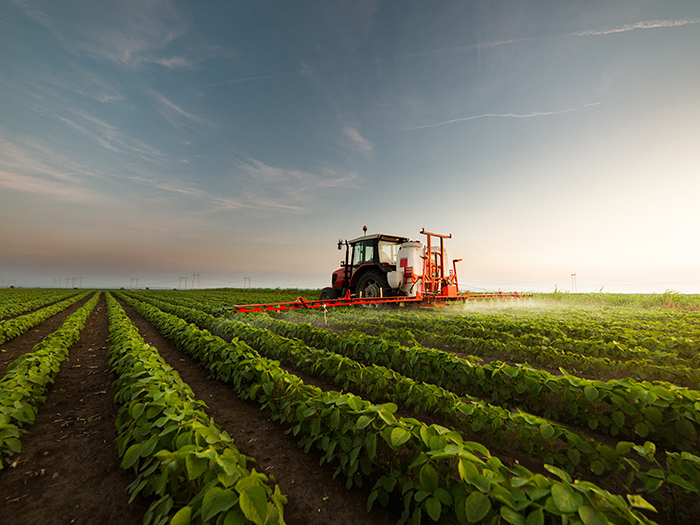Sponsored Content by QBE
How Crop Insurance Helps to Minimize 5 Key Risks Facing American Farmers

Farming has never been an easy business. Success depends largely on factors outside of anyone’s control — rainfall, sunshine, humidity, etc. Today, the pressures on the average American farmer go beyond the whims of Mother Nature and are only growing more intense.
When the agricultural sector is at risk, everyone is at risk. Without protections in place to help farmers recover quickly from losses, food supply becomes stilted and society pays the price. Federally funded crop insurance has provided a safety net for farmers since 1938, but even this program is not a perfect solution.
“It’s important for everybody to have a safe and affordable food supply. That’s the basis of the policy in the U.S. with regards to crop insurance,” said James Korin, President of NAU Country Insurance, a QBE Insurance Company. “The biggest challenge, however, is that commodity prices and the revenue per acre shrink over time. The farmers have to get bigger, and they have to be more efficient with the way they spend their money.”
In the face of new challenges, it’s become increasingly important for farmers to partner with crop insurance providers who not only provide funds, but also bring expertise and resources that help to minimize loss and expedite recovery.
Here are five key challenges facing farmers today, and why their choice of crop insurer matters:
1. Global Market Volatility

James Korin, President of NAU Country Insurance, a QBE Insurance Company
A few trends in the global food supply chain are tightening margins for U.S. farmers. First, increased soybean and corn production from South America, where farmers have planted more of these crops in place of waning rainforests, have posed competition for and lowered prices of American crops.
The ongoing and ever-changing trade war with China further complicates matters.
“Over the past 18 months or so, the China trade deal has really affected the price of some key exports, like beans,” Korin said. “The effects of tariffs on those crops and some decline in demand have put a tremendous stress on our farm prices.”
The effects of COVID-19, felt by every sector, are also diminishing farmers’ ability to ship products overseas. The impact of the pandemic on the stock market has also eaten into operating capital.
“The dramatic stock market volatility we’ve seen recently is affecting day-to-day cash flows on the American farm,” Korin said.
2. More Extreme Weather, More Often
According to the USDA, weather-induced crop losses have entered into the tens of millions every year since 1989. In 2012, a severe drought and early Spring freeze caused more than $100 million in crop losses — the biggest impact on record so far, but perhaps not for long.
Last year, a summer of severe flooding forced Midwest farmers to delay planting of corn and soybeans over about 19.4 million acres. Wildfires that ripped through California destroyed millions of acres of farm and ranch land. An artificially early Spring and subsequent drops into freezing temperatures caused Michigan to lose 90% of its cherry crop several years ago.
Though the impact varies by region, type of crop and type of weather event, the growing geographical footprint of severe weather patterns means every farm is increasingly exposed.
“Over the last five years especially we’ve seen more extreme fluctuations in weather, affecting broader geographical regions than they have in the past,” Korin said. “As these events continue and the losses build, it will become tougher for farmers to recover.”
3. The Double-Edged Sword of Technology
For many industries, technology has enabled a more proactive approach to risk management, and agriculture is no different.
More advanced environmental sensors, aerial imaging, weather-tracking capabilities and analytical tools have made it possible for farmers to better prepare for weather fluctuations and make real-time adjustments to planting and harvesting schedules, thereby minimizing crop losses. High-tech equipment like self-driving tractors also makes farming more efficient, saving time and reducing labor costs.
But, technology always introduces its own set of risks. Advanced equipment will also come with higher repair and replacement costs if damaged, adding to financial constraints. And of course, digital technology is always susceptible to bugs and system failure.
“The technology that’s on the American farm today is helping farmers plant more accurately and in different conditions. Of course, these tools come with a cost,” Korin said. “Farmers have to invest in these technologies, which may eat into profit margins initially and increase the importance of having a strong safety net in the event of disaster.”
4. Changing Consumer Preferences
Though some staple crops like corn, soybean and wheat will always be in demand, many farmers grow specialty crops that are more subject to consumer whims and that ebb and flow with sociocultural trends.
“Farmers have to react to consumer demand, so they are either looking for ways to change what they grow, or working to identify different markets for the same product,” Korin said. “Consumer preferences tend to change more rapidly than they have in the past, thanks in part to the influence of social media, so farmers have less time to respond.”
The advent of “athleisure,” for example, has driven a shift away from cotton and toward the synthetic materials used to make workout attire. Aligning with the growth of the cannabis industry, industrial hemp has become a go-to fiber for some textile manufacturers. The tobacco industry, already a small subset of the U.S. agricultural sector, is shrinking as smoking rates continue to decline.
Demand for organic food is also on the rise. The number of certified organic farms in the U.S. grew by 56% between 2011 and 2016. While this presents opportunity for some, it also poses a threat to conventional farming.
5. Unreliable Government Support
Though crop insurance is federally funded, farmers have received additional support from the government in the form of direct payments and subsidies. These payments, however, are subject to appropriation reductions that are on the table every year.
“Any program in the U.S. dependent on government dollars is being stressed by the fact that our government is so far in debt,” Korin said. “The market facilitation payments that were disbursed over the past year to help with market declines, for example, were disaster-level payments that took an act of Congress to get funded. It’s helped the farmers, but farmers can’t wait around while the government debates the merits of those payments. They just can’t operate that way.”
That’s why the crop insurance program is considered the primary safety net for farmers. As a standing program, it is not subject to appropriation reductions and receives funding automatically through the Farm Bill.
Why Choice of Crop Insurer Matters
Crop insurance is unique in that, as a federal program, the rates, rules, underwriting and loss adjustment procedures are established by the Risk Management Agency of the USDA. The carriers who bring these policies to market, therefore, aren’t competing on their products as much as their level of service.
And there is a lot that crop insurers can do beyond providing policies to help farmers overcome their challenges. For starters, best in class crop insurers leverage their technology and expertise to help farmers reduce their exposure.
“QBE has invested heavily in precision agriculture. We’ve built a suite of products called Field Insights that allow farmers to look more closely at a variety of growing conditions in order to better plan their schedule. This data can help them decide which type of seed to buy, the best time to plant, when to spray chemicals, when to harvest, etc.,” Korin said.
Technology can also help farmers respond to losses faster. After a weather event, QBE’s geo-mapping tools allow farmers to examine their fields and identify harder-hit areas more quickly, which expedites the claim process and allows recovery to begin sooner.
The loss adjusting team, however, may be the biggest bonus of a QBE policy. Scattered across 10 regional offices, QBE’s adjusters are positioned to respond to a loss typically within one to three days.
“We pay a lot of our claims the same day we go out and look at the field, and we inspect every single claim that is made,” Korin said. “Most of our adjusters come from the agricultural industry, so they understand what they’re looking at when they do an inspection, and they understand farmers’ needs. And because they focus on one region, they have expertise in the specific types of crop in that area.”
Paying claims not just quickly but accurately is also a priority. A proprietary, integrated claims system that collects all of the loss data in one place helps to eliminate errors and get payments right the first time. All of this helps farmers to move forward faster and mitigate the impact of increasingly unpredictable risks.
To learn more, visit https://www.naucountry.com/.
This article was produced by the R&I Brand Studio, a unit of the advertising department of Risk & Insurance, in collaboration with QBE. The editorial staff of Risk & Insurance had no role in its preparation.










